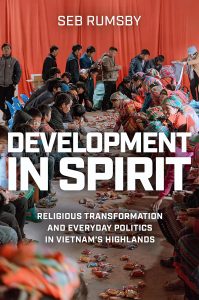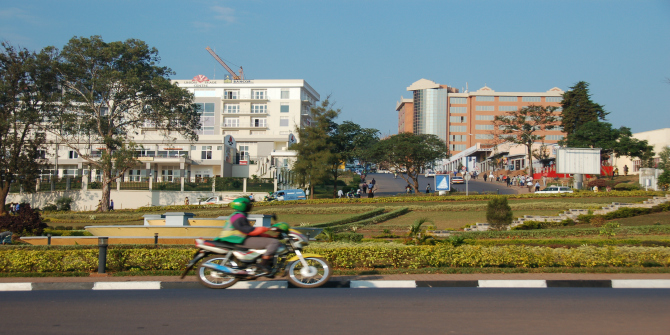In Development in Spirit: Religious Transformation and Everyday Politics in Vietnam’s Highlands, Seb Rumsby examines how mass conversion to Christianity among Hmong communities in rural Vietnam led to “unplanned development”. This ambitious and compelling study shows how the Hmong achieved an alternative development trajectory that involved simultaneous integration into the market economy and resistance to state authority, writes Phill Wilcox. This post was originally published on the LSE Southeast Asia Blog.
Development in Spirit: Religious Transformation and Everyday Politics in Vietnam’s Highlands. Seb Rumsby. University of Wisconsin Press. 2023.
 Development, but whose form of development, how and where do these forms of development conflict? What happens when a community typified as hard to reach and living in poverty expresses considerable enthusiasm for a form of development not sanctioned or endorsed officially by the state?
Development, but whose form of development, how and where do these forms of development conflict? What happens when a community typified as hard to reach and living in poverty expresses considerable enthusiasm for a form of development not sanctioned or endorsed officially by the state?
In an ambitious and compelling study, Rumsby offers a valuable contribution to scholarship on an ethnic and religious minority
These questions are explored in great detail in Seb Rumsby’s Development in Spirit: Religious Transformation and Everyday Politics in Vietnam’s Highlands. In an ambitious and compelling study, Rumsby offers a valuable contribution to scholarship on an ethnic and religious minority, how their aspirations intersect and conflict with those of the state, and how development becomes both an individual and collective project. Researched and written in vivid detail, and based on excellent empirical material, this book underlines the importance of long-term study. Rumsby demonstrates familiarity with his research context, built up over many years. I was particularly struck by the attention to detail, which helps bring the arguments and descriptions to life.
For the Hmong of Vietnam, conversion to protestant Christianity provides options for development that sometimes intersect with the development aspirations of the state, and at other times conflict with this.
This is timely, and important, for thinking about development in different ways: as a top-down process but also as personal and collective agency. Rumsby argues that for the Hmong of Vietnam, conversion to protestant Christianity provides options for development that sometimes intersect with the development aspirations of the state, and at other times conflict with this. In so doing, he builds on work everyday resistance in Vietnam and its implications for transforming government policy (Kerkvliet 2005) and more specifically, by Ngo (2016) on Christian conversion as a new path to development. Rumsby makes an important point in noting that Christian conversion is not entirely new in Vietnam anymore, and over the last three and a half decades, has seen over 1.6 million Hmong convert.
To introduce this phenomenon in Rumsby’s case study, he begins with an authoritative chapter on context. While this is comprehensive, some already familiar with Vietnam might find it slightly too long. Nevertheless, it also provides context to the important theoretical arguments raised in the book, especially around resistance, governance, and development. Religious conversion as a process and outcome of everyday resistance interfacing with development as a strategy pursued by the Hmong of Vietnam extends Scott’s work on The Weapons of the Weak in novel and interesting ways, something that Rumsby argues for effectively. Typified as underdeveloped, and hard to reach, the Hmong are shown to be receptive to the notions of development, but also specific forms of development arising from Christian conversion and where these conflict with state agendas. The contribution of this book does not stop there, as Rumsby focuses squarely on what the consequences of Christian conversion are for all parties. While the Hmong and the state have internalised the will to improve or to become something more than what one is currently, on the ground, authorities worry about religious affiliations as contesting their legitimacy. Moreover, in the form of Christian conversion, development to the Hmong can and does look different to the development agendas pursued by the state. In the case of the Hmong, their trajectories of development fall largely outside state planning, which leads to points of cooperation and tension. What this means for overall development policy in Vietnam is a point I would have liked to come out more strongly.
Rumsby is […] right to grapple with the concept of development itself being less than self-evident, and to question whether it means the same to Christian and non-Christian Hmong
But in thinking about what these alternative routes to development mean for the Hmong, Rumsby does not lose sight of the very real value of his work here, which is the rich level of detail at local levels, and the everyday detail he gives the reader for Hmong who convert and for those who do not. Rumsby is also right to grapple with the concept of development itself being less than self-evident, and to question whether it means the same to Christian and non-Christian Hmong (7). In a similar vein, it is refreshing, and vital, to see development and underdevelopment treated throughout the book as not only a matter of finance and access or lack of access to money and markets.
This book is about agency and what people do with it within a limited range of options and shifting landscapes of possibilities.
This book is about agency and what people do with it within a limited range of options and shifting landscapes of possibilities. While conversion as a trajectory for development may sound positive, one of the most intriguing parts of this book for me is chapter 4, where Rumsby recognises the very real consequences of neoliberalism’s inroads in the lives of the Hmong. In encouraging entrepreneurship, and self-directed paths to development (within the boundaries of protestant Christianity), Rumsby outlines where and how inequality is produced and reproduced amongst the Hmong. As Rumsby notes, “not waiting for the state” (96) has become a mantra amongst converted Hmong. But while this is about individual actions, it is also about the collective. Who does what, and in the name of whom and what, is a theme that builds on chapter 3, where he also outlines in detail how some Hmong have managed to accrue power and influence through conversion and how they can exercise this power over others, and towards external forces such as the Vietnamese state and NGOs by acting as consultants and development brokers. This chapter is particularly important because it outlines how the politics of representation works amongst the Hmong. This is a theme picked up again in chapter 5, where Rumsby makes some insightful observations on what conversion means for gender relations and how Hmong women can overcome aspects of subordination through conversion, but then face new forms of patriarchal control and sexism. The question of whether Hmong women will ever be allowed to become pastors themselves remains an open question (chapter 5), and one worth watching closely.
Rumsby makes some insightful observations on what conversion means for gender relations and how Hmong women can overcome aspects of subordination through conversion, but then face new forms of patriarchal control and sexism.
At the end of this important book, readers will have learned a considerable amount about the Hmong of Vietnam, and about Christian conversion amongst them. This is a vivid, and important, picture of development in process. The only thing I found missing was any sense of how Hmong Christian conversion is different (or not) from Protestant Christian movements elsewhere. Chapter 4 includes a fascinating section on prosperity theology, which has enjoyed huge success beyond Vietnam and particularly in Africa. Rumsby notes at the outset that the context of late socialism is a unique one, but I would still be fascinated to know how far Rumsby considers the situation in Vietnam to differ from Christian conversion movements and their intersections with development elsewhere. But perhaps that is a subject for a fascinating future book.
This book review is published by the LSE Southeast Asia blog and LSE Review of Books blog as part of a collaborative series focusing on timely and important social science books from and about Southeast Asia. This review gives the views of the author, and not the position of the LSE Review of Books blog, the LSE Southeast Asia Blog, or the London School of Economics and Political Science.
Main Image Credit: pornpoj on Shutterstock.







